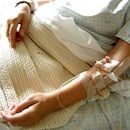
Handover at the Bedside: A Simple Strategy to Improve Care
At shift change, incoming and outgoing nurses transfer accountability by exchanging information about the patients under their charge (Patterson, 2008). An effective handover supports the transition of critical information and provides continuity of care, whereas poor communication at handover can jeopardize patient safety. New research suggests that by moving the handover process to the patient’s bedside, nurses’ can empower patients to become involved in their own care, which improves patient safety and patient satisfaction ratings.
Clinical environments are dynamic and complex, presenting many challenges for effective communication (Friesen et al., 2008). Some nursing units may transfer or discharge 40-70% of their patients every day. This high turn-over rate illustrates the number of possible breaches at each transition point (Friesen et al., 2008). Shift change is generally the most vulnerable time on the patient care continuum. Ineffective handovers can contribute to gaps in patient care and breaches in patient safety, including inaccurate medication prescriptions, inaccurate or incomplete evaluations, increased length of stay, and increased use of laboratory testing (Patterson, 2008). By bringing the handover to the bedside, nurses can engage the patient in his or her care plan and provide a more comprehensive discussion of care to improve patient safety and outcomes.
The issue of handover has become so prominent that The Joint Commission (TJC) developed a National Patient Safety Goal (NPSG) on handoffs. This goal requires health care organizations to implement a standardized approach to handoff communications, including an opportunity to ask and respond to questions (TJC, 2013). While the goal may appear simple, it is challenging to develop and implement effective strategies for handoffs across various healthcare settings, given the complexity of healthcare delivery (Friesen et al., 2008). Yet a simple strategy to improve communication is to bring the report to the patient’s bedside. This facilitates the earlier connection between the oncoming nurse and the patient and presents an opportunity for the patient to ask questions and clarify information with both nurses. It also provides an opportunity for the two nurses to assess the patient together, which can reduce patient safety errors. Research recently published in the Journal of Nursing Care Quality found that bedside handover relieved anxiety and improved patient satisfaction (Lianne et al., 2013).
On the downside, handover at the patient's bedside may result in more interruptions during the report, if the patient requests clarification on issues discussed. It can also concern patients if medical jargon is used without explanation to the patient. In addition, some patients may not wish to participate in the process and confidentiality issues need to be addressed. Thus, patients should be given the opportunity to participate in the handover process, but respected if they do not wish to be part of the process.
Best practice recommendations suggest the use of a standardized process to promote the transmission of essential information during handover and recommend that units develop protocols to guide the bedside handover process (Friesen et al., 2008).
You can make a difference in your patient’s safety and satisfaction by bringing the possibility of bedside handovers to your unit’s attention. For more information on implementing bedside handover, review Chapter 13 of the AHRQs resource entitled An Evidence-Based Handbook for Nurses.
References:
Friesen, M.A., White, S. & Byers, J. (2008). Chapter 34. Handoffs: Implications for Nurses. Patient Safety and Quality: An Evidence-Based Handbook for Nurses
Lianne et al. (2013). Patients Views on Bedside Nursing Handover. Journal of Nursing Care Quality, 2013.
Patterson, E. (2008). Dangerous Shift: The Commentary. Challenges at Shift Change. Agency for Healthcare Quality & Research (AHRQ).
St. Michael's Hospital (2013). Involving patients in nurses' shift change reduces medical errors, satisfies patients. ScienceDaily.
The Joint Commission [TJC], (2013). 2013 Hospital National Patient Safety Goals.




